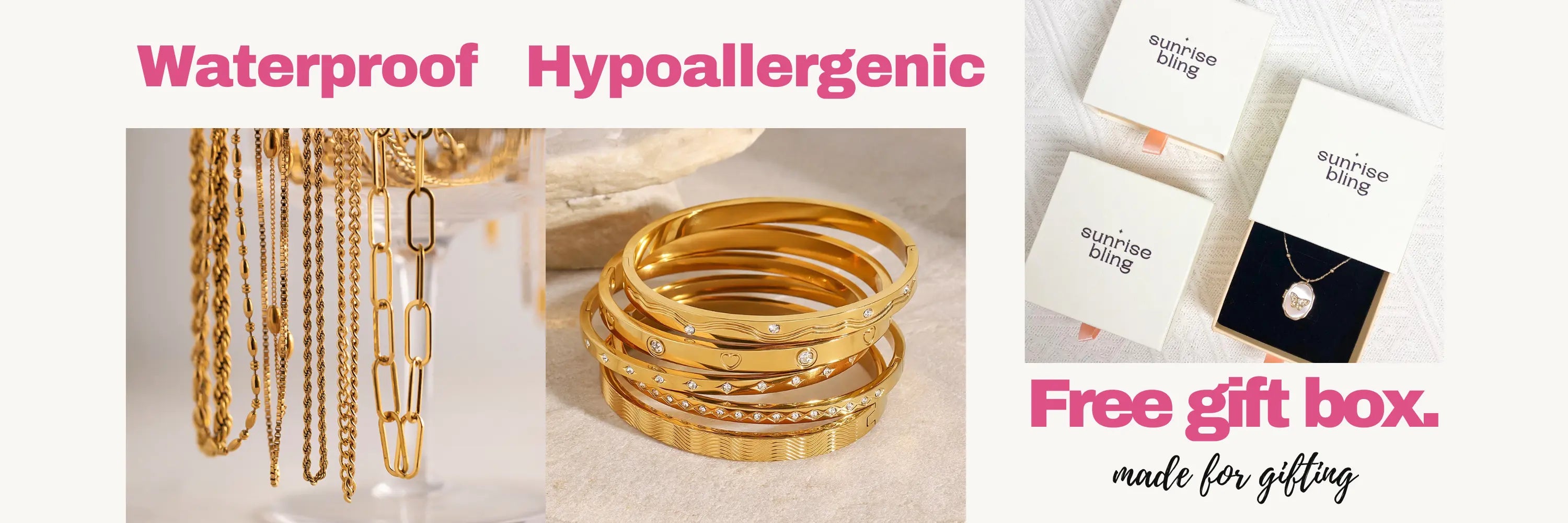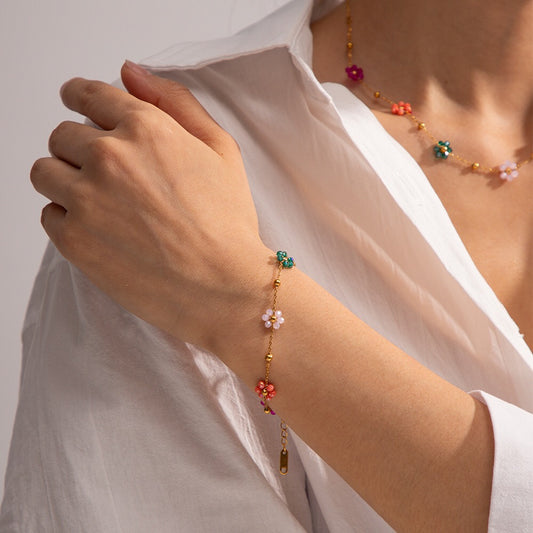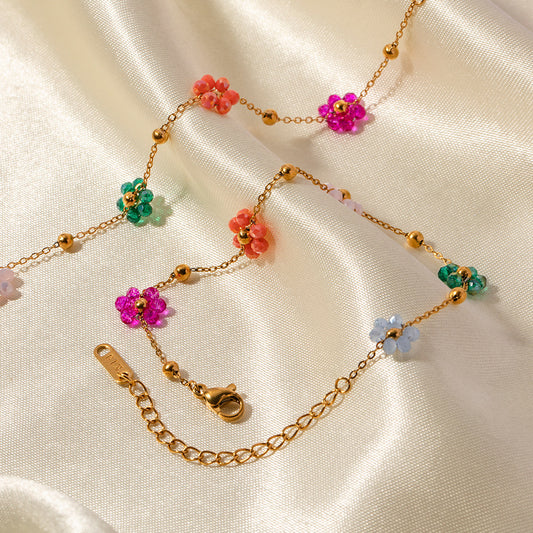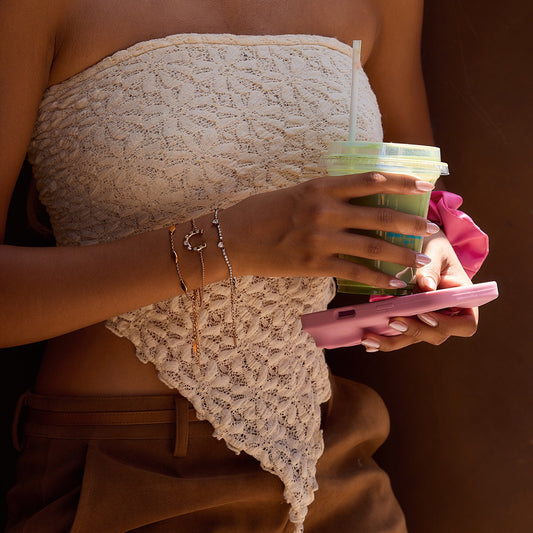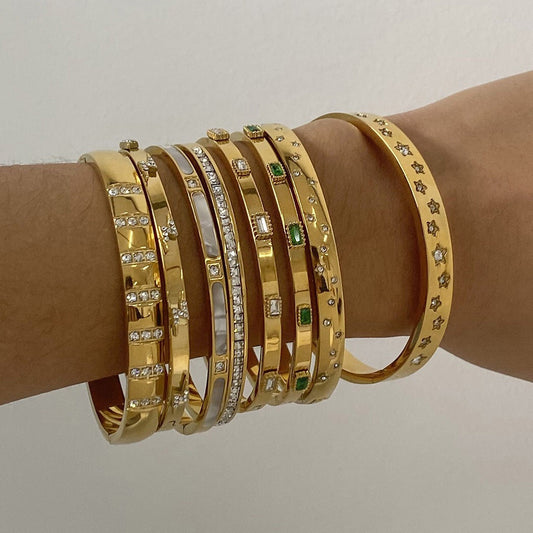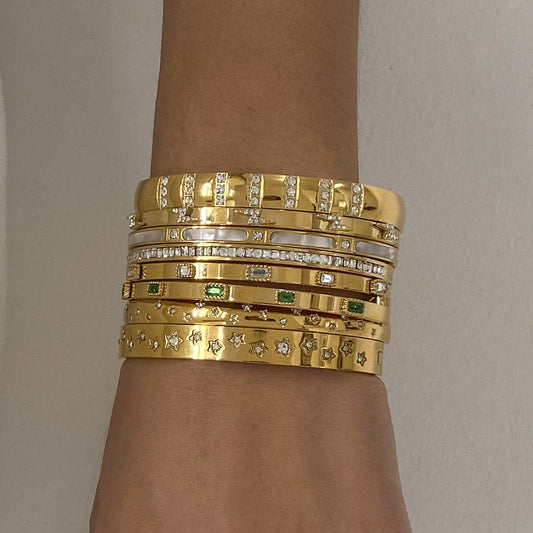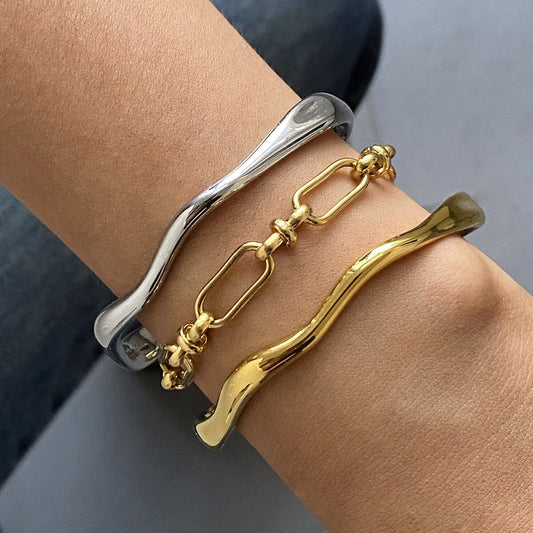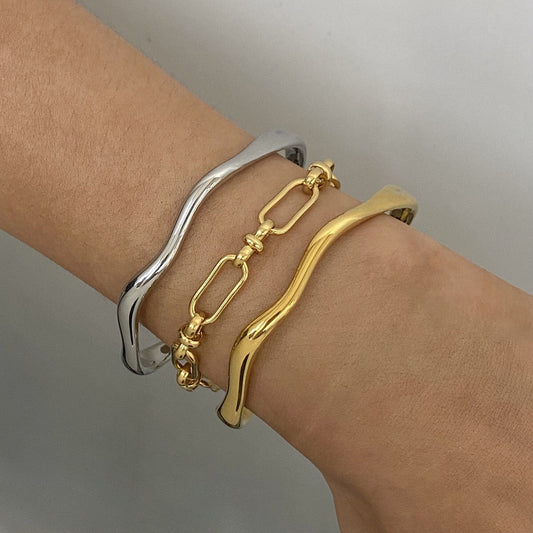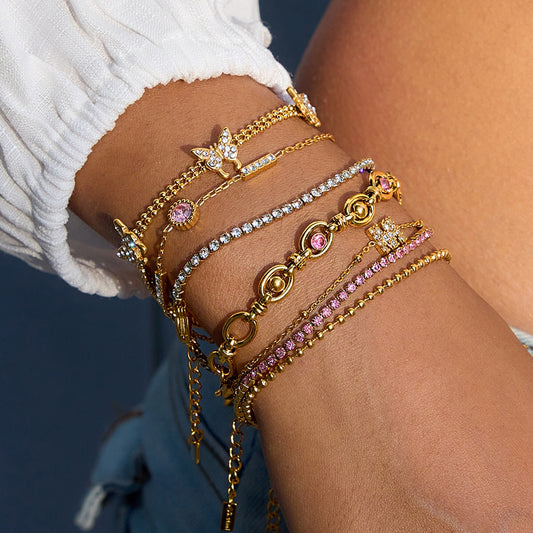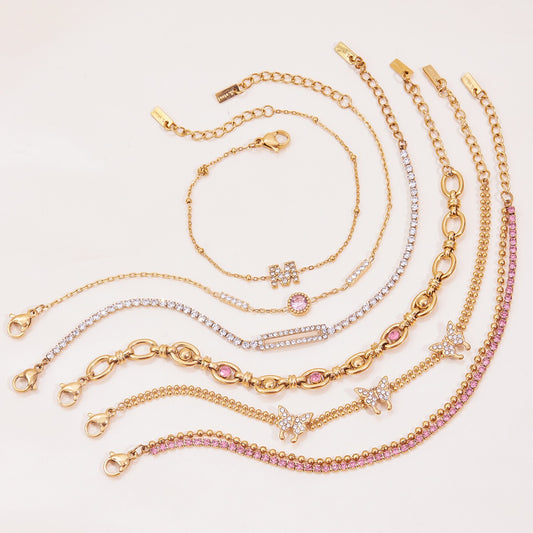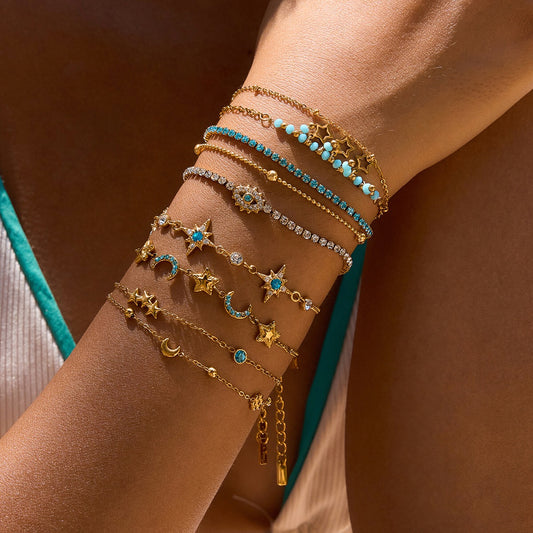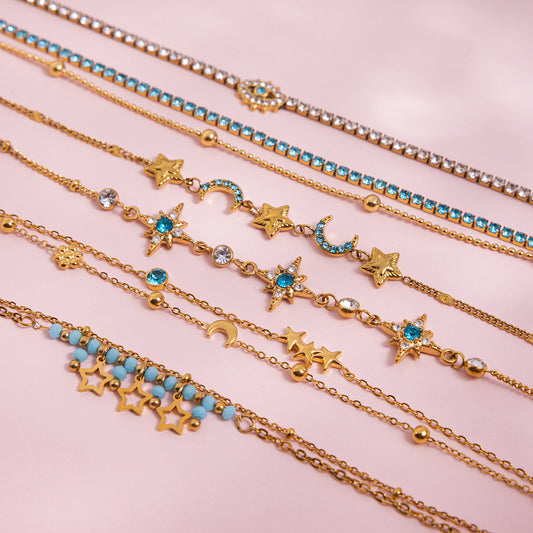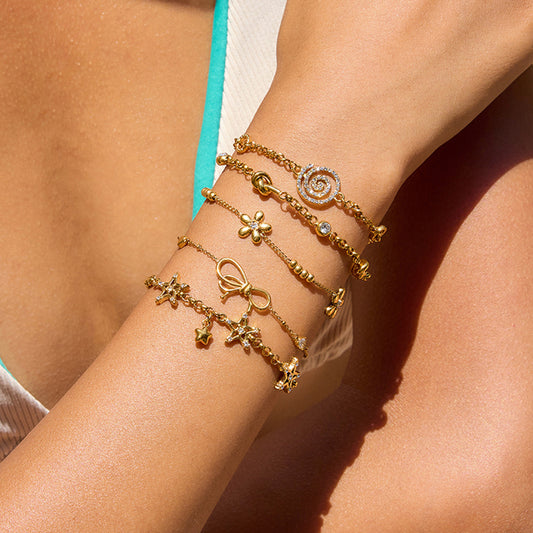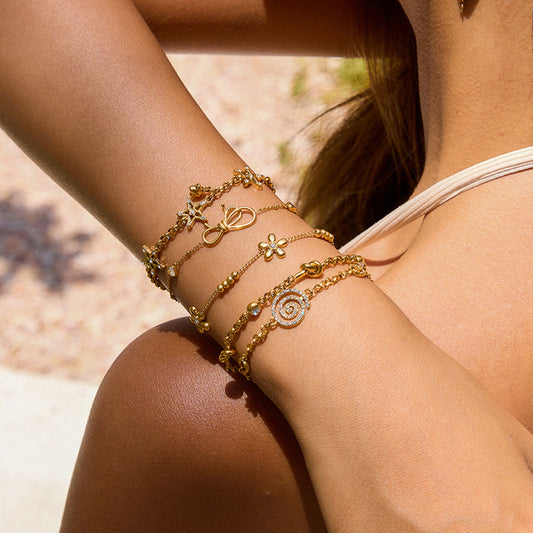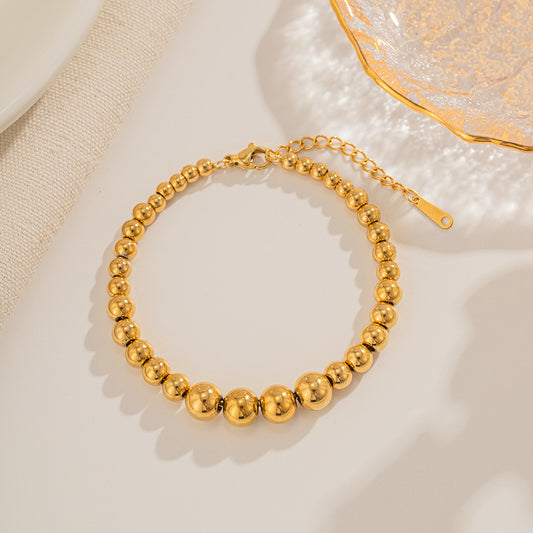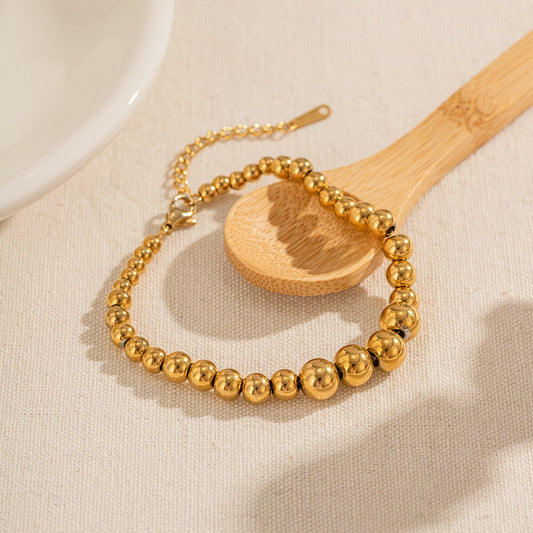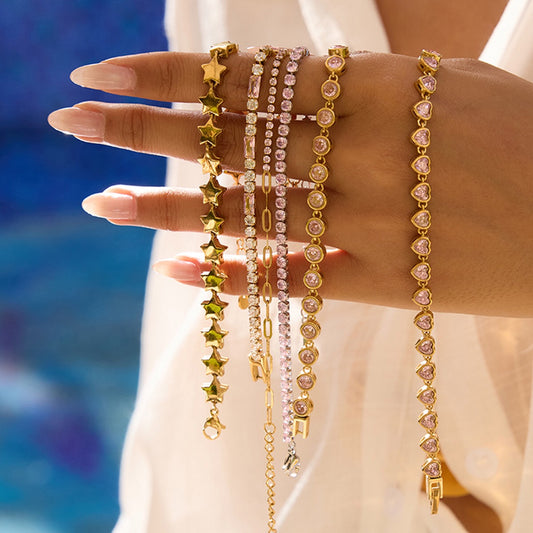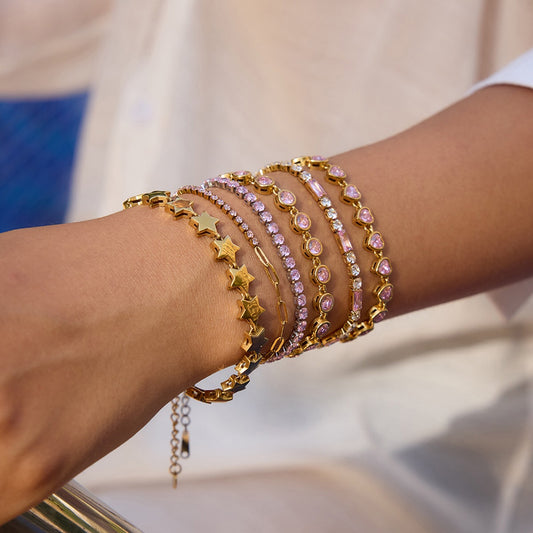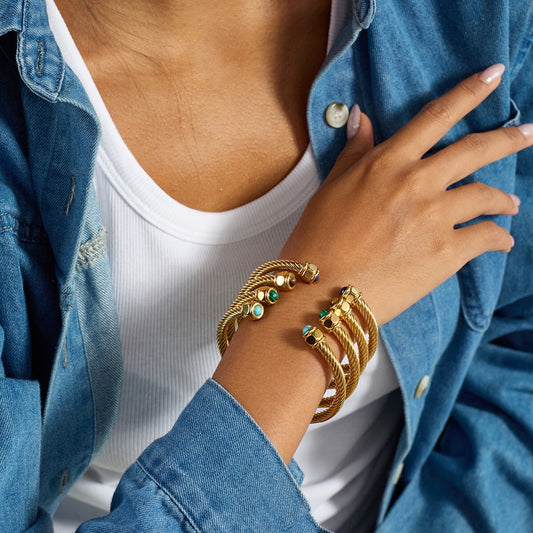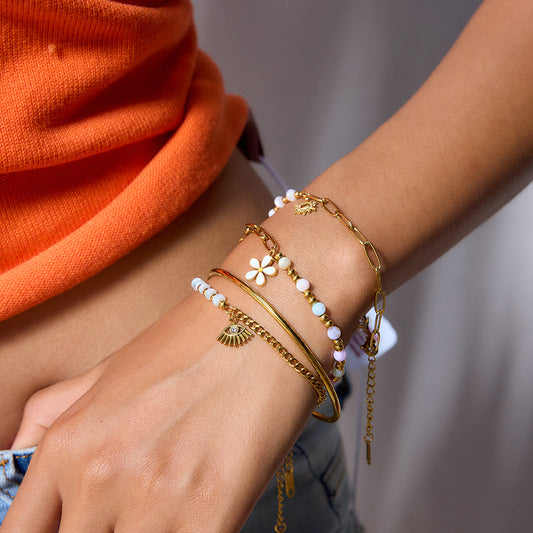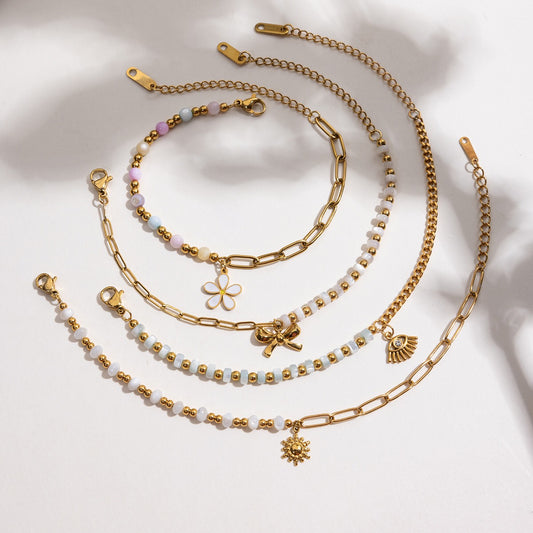Bracelet diamond bracelet has become a staple in jewelry collections worldwide, living up to its promise of “glamour for every outfit” with its dazzling diamonds and versatile design. The global diamond jewelry market size was estimated at USD 340.6 billion in 2022 and is projected to reach USD 482.2 billion by 2030, growing at a CAGR of 4.6% from 2023 to 2030. What makes this accessory stand out? Unlike bold diamond necklaces or statement earrings that can feel over-the-top for daily wear, a bracelet diamond bracelet adds subtle yet impactful sparkle: it elevates casual jeans and a tee, complements professional workwear, and shines alongside formal gowns. Whether you’re drawn to a classic tennis bracelet or a modern pavé design, a bracelet diamond bracelet blends luxury with practicality, making it a go-to for both personal wear and gifting. Let’s explore what defines these bracelets, why they’re so beloved, and how to choose, style, and care for them.

What is Bracelet Diamond Bracelet
Definition and Core Design
A bracelet diamond bracelet is a jewelry piece featuring diamonds (natural or lab-grown) set into a metal band (typically gold, white gold, platinum, or sterling silver) that wraps around the wrist. The “bracelet diamond” label emphasizes the central role of diamonds—unlike diamond-accented bracelets (which have just a few small diamonds), these bracelets showcase diamonds as the focal point, either in a continuous line, clustered design, or scattered pattern. Key design elements include:
-
Diamond Setting: The way diamonds are secured to the band—common styles include prong (lifts diamonds to maximize sparkle), bezel (wraps metal around diamonds for protection), and pavé (small diamonds set closely together to create a “paved” look of continuous shine).
-
Band Length: Typically 7–7.5 inches long (with 0.5–1 inch extenders for a custom fit) to accommodate most women’s wrists, ensuring comfort without slipping off during daily activities.
-
Clasp Type: Secure closures like lobster clasps (easy to open/close) or box clasps (with safety latches) prevent the bracelet from falling off—critical for protecting the valuable diamond design.
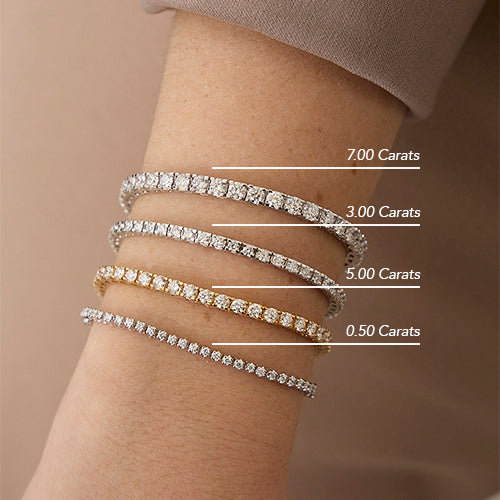
Types of Diamonds Used in Bracelet Diamond Bracelets
The quality and type of diamonds in a bracelet diamond bracelet vary based on budget and preference, with three main categories:
-
Natural Diamonds: Mined from the earth, valued for their rarity and natural beauty. Graded by the 4 Cs (cut, color, clarity, carat weight)—higher-quality natural diamonds (e.g., D-color, VS1 clarity) create more intense sparkle but come with a premium price tag.
-
Lab-Grown Diamonds: Created in a controlled laboratory environment with the same chemical composition as natural diamonds. They offer identical sparkle and durability but cost 30–50% less, making them a popular choice for budget-conscious or eco-conscious shoppers.
-
Diamond Simulants: Imitation diamonds like cubic zirconia (CZ) or moissanite. While they mimic the look of diamonds, they lack the same hardness (CZ scores 8.5 on the Mohs scale vs. 10 for diamonds) and brilliance—best for affordable, occasional-wear bracelets.
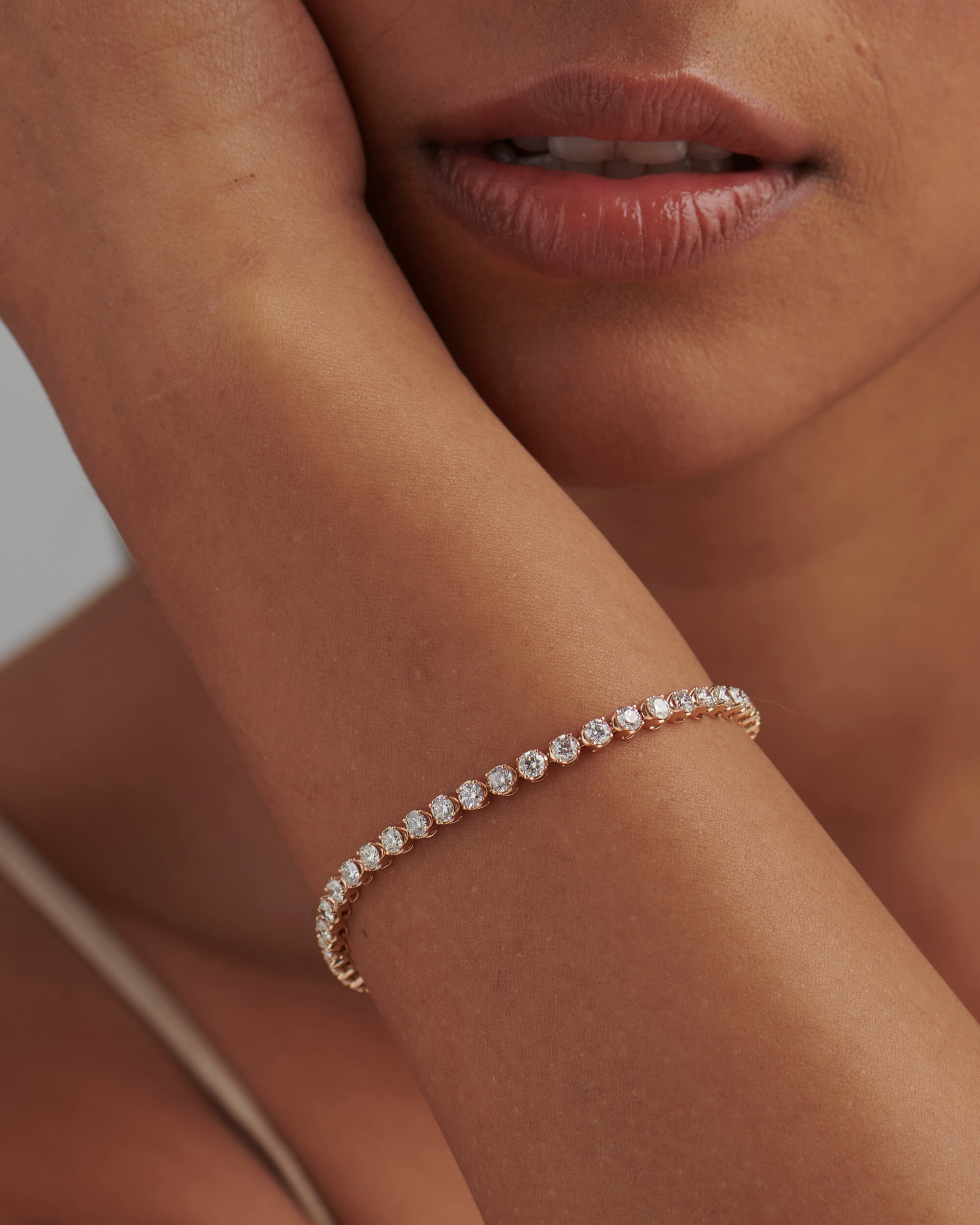
How Bracelet Diamond Bracelets Differ from Other Diamond Jewelry
Bracelet diamond bracelets stand out from other diamond accessories (e.g., necklaces, earrings) due to their unique balance of visibility and subtlety:
-
Wearability: Unlike diamond necklaces (which can feel heavy or restrictive) or earrings (which may irritate sensitive ears), bracelet diamond bracelets are lightweight and comfortable for all-day wear—you’ll barely notice them until they catch the light.
-
Versatility: They’re the only diamond jewelry that works for every occasion—from running errands to black-tie events. A diamond necklace may be too formal for casual outings, but a bracelet diamond bracelet adds just the right amount of glamour without feeling out of place.
-
Focus on Movement: The bracelet’s position on the wrist means diamonds catch light with every gesture (typing, reaching for a coffee cup), creating dynamic sparkle that’s more eye-catching than static diamond jewelry like rings.
Why is Bracelet Diamond Bracelet so popular
“Glamour for Every Outfit” Core Appeal
The top reason bracelet diamond bracelets are popular is their ability to deliver “glamour for every outfit.” They’re the ultimate “one-size-fits-all” accessory:
-
Casual Wear: A thin pavé bracelet diamond bracelet pairs with a graphic tee and jeans—adds a touch of luxury to a laid-back look without overcomplicating it.
-
Workwear: A classic tennis bracelet (with small diamonds) complements a blazer and tailored pants—polished enough for meetings, but subtle enough to avoid distracting colleagues.
-
Formal Events: A statement bracelet diamond bracelet (with larger diamonds or a clustered design) elevates a little black dress or evening gown—turns a simple outfit into a showstopper.
This versatility means you can invest in one bracelet and wear it daily, rather than buying multiple accessories for different occasions.
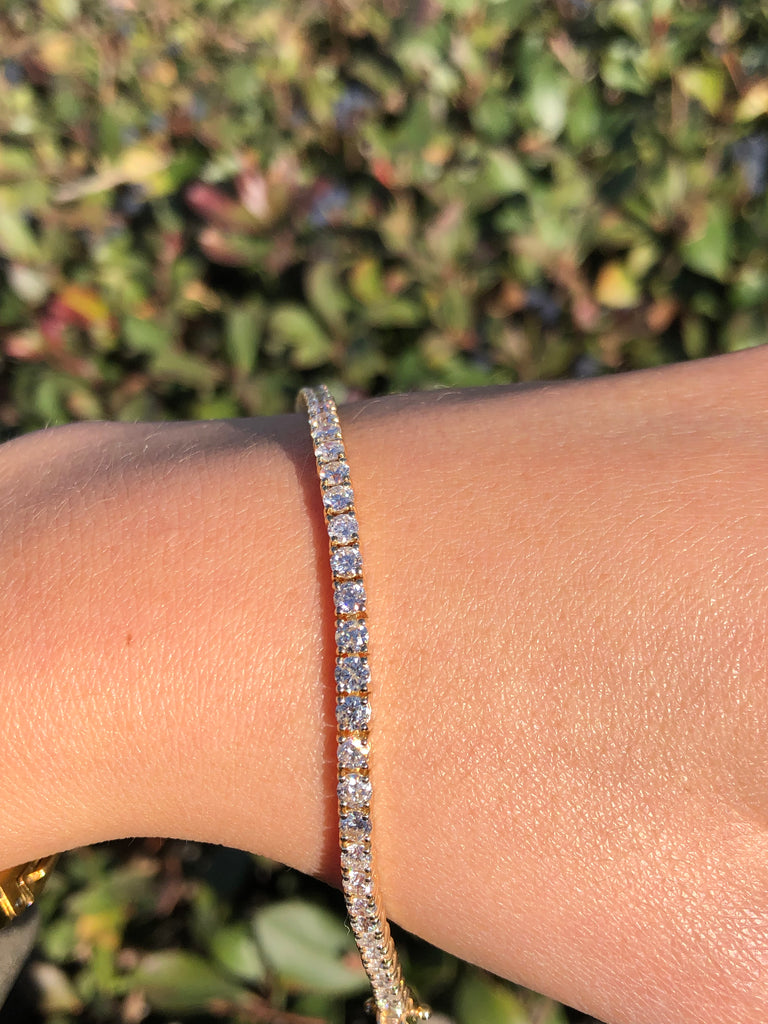
Timeless Elegance That Never Goes Out of Style
Unlike trendy jewelry (e.g., chunky chain bracelets or beaded designs) that fades from fashion, bracelet diamond bracelets have been popular for decades—and they’ll remain stylish for years to come. The classic tennis bracelet, for example, was popularized in the 1980s (by tennis star Chris Evert) and is still a top seller today. Their timeless design makes them a wise investment: they won’t feel outdated next season, and they can even be passed down as family heirlooms.
Durability for Daily Use
High-quality bracelet diamond bracelets are built to last—thanks to durable metals and secure diamond settings:
-
Metal Durability: 14k/18k gold, platinum, and sterling silver are scratch-resistant and tarnish-resistant, standing up to daily activities like typing, cooking, or working out.
-
Diamond Hardness: Diamonds are the hardest natural material (Mohs scale 10), so they won’t scratch or chip easily—even with frequent wear.
-
Secure Settings: Prong, bezel, and pavé settings keep diamonds in place, reducing the risk of loss (though it’s still wise to check clasps regularly).
With proper care, a bracelet diamond bracelet can last 20–30 years or more—making it a long-term investment in style.

Emotional and Sentimental Value
Bracelet diamond bracelets often carry deep meaning, adding to their popularity:
-
Milestone Gifts: They’re a top choice for significant moments like graduations, promotions, anniversaries, or birthdays—symbolizing achievement, love, or celebration.
-
Heirloom Potential: Many families pass down bracelet diamond bracelets from generation to generation, turning a piece of jewelry into a tangible link to family history.
-
Self-Love Treat: More and more people are buying bracelet diamond bracelets for themselves as a way to celebrate personal growth or reward hard work—they’re a reminder of self-worth and confidence.
Popular styles of Bracelet Diamond Bracelet
Tennis Bracelet (Classic Style)
The most iconic bracelet diamond bracelet style—features a continuous line of identically cut diamonds (usually round or princess-cut) set in a thin metal band.
-
Design: Diamonds are typically 0.25–0.5 carats each, with a total carat weight (TCW) of 1–3 carats. The band is sleek and flexible, lying flat against the wrist.
-
Why It’s Popular: Timeless and versatile—works for every occasion, from casual to formal. Its simple design lets the diamonds’ sparkle take center stage, making it a favorite for both everyday wear and special events.
-
Best For: Minimalists, lovers of classic jewelry, or anyone looking for a “forever” bracelet that never goes out of style.
Pavé Bracelet Diamond Bracelet (Modern Sparkle)
Features tiny diamonds (0.01–0.05 carats each) set closely together on the band, creating a “paved” surface of continuous sparkle.
-
Design: The small diamonds are held in place by tiny prongs or bezel settings, with little to no metal visible between them. The band can be thin (2–3mm) for subtlety or thick (4–5mm) for more impact.
-
Why It’s Popular: Delivers maximum sparkle without the cost of larger diamonds—great for budget-conscious shoppers who want a “full diamond” look. The continuous shine makes it perfect for evening events, but it’s still delicate enough for daily wear.
-
Best For: Trendy wearers, those who love subtle yet eye-catching sparkle, or pairing with other thin bracelets.
Cluster Bracelet Diamond Bracelet (Statement Style)
Features groups of diamonds (clusters) set at intervals along the band, rather than a continuous line.
-
Design: Each cluster has 3–5 diamonds (mix of sizes) arranged in a flower, heart, or geometric shape. The band between clusters is often plain metal or has small accent diamonds.
-
Why It’s Popular: Adds visual interest and dimension—more bold than a tennis bracelet but still wearable. The clusters create focal points of sparkle that catch the light from every angle.
-
Best For: Formal events, date nights, or anyone who wants a bracelet that stands out without being overly flashy.
Bangle Bracelet Diamond Bracelet (Edgy Elegance)
A rigid, circular bangle (instead of a flexible chain) with diamonds set on the outer surface.
-
Design: Available in single or stacked styles (multiple thin bangles). Diamonds can be in a continuous line, scattered pattern, or clustered on one side of the bangle.
-
Why It’s Popular: Offers a modern, edgy twist on classic diamond bracelets. Stackable designs let you mix and match (e.g., a diamond bangle + a plain metal bangle) for a personalized look.
-
Best For: Fashion-forward wearers, pairing with casual or bohemian outfits, or adding a touch of glamour to workwear.
How to wear Bracelet Diamond Bracelet
Pairing with Outfits (By Occasion)
-
Everyday Casual:
-
Outfit: High-waisted blue jeans, a white cropped tee, and white sneakers.
-
Bracelet Diamond Bracelet: A thin pavé bracelet (0.5 TCW) in sterling silver. The subtle sparkle adds a luxe touch to the casual look without feeling overdone—perfect for running errands or meeting friends for coffee.
-
Work/Professional:
-
Outfit: A navy blazer, a light blue button-down shirt, and tailored black trousers.
-
Bracelet Diamond Bracelet: A classic tennis bracelet (1 TCW) in white gold. The small, uniform diamonds are office-appropriate—they add polish without distracting during meetings or presentations.
-
Date Night:
-
Outfit: A black slip dress, strappy gold heels, and a small clutch.
-
Bracelet Diamond Bracelet: A cluster bracelet (1.5 TCW) in rose gold. The clustered diamonds create eye-catching sparkle that complements the dress, while the rose gold adds a romantic touch.
-
Formal Event (Wedding/Gala):
-
Outfit: A floor-length silver sequined gown or a black velvet dress.
-
Bracelet Diamond Bracelet: A statement bangle bracelet (2–3 TCW) in platinum. The rigid bangle stays in place during dancing, and the platinum’s cool tone pairs beautifully with sequins or velvet.
Styling Tips for Different Wrist Sizes
A bracelet diamond bracelet should fit comfortably and flatter your wrist—follow these tips based on your wrist size:
-
Petite Wrists (Less Than 6.5 Inches): Opt for thin styles (2–3mm band) with smaller diamonds (0.25–0.5 TCW). A tennis bracelet or thin pavé bracelet will avoid overwhelming your wrist. Add a 0.5-inch extender to ensure a loose enough fit (you should be able to slide one finger between the bracelet and your wrist).
-
Average Wrists (6.5–7.5 Inches): Most styles work—try a medium-width tennis bracelet (3–4mm band) or a cluster bracelet. The average length (7 inches) will fit perfectly with a small extender for adjustability.
-
Larger Wrists (More Than 7.5 Inches): Choose thicker bands (4–5mm) with larger diamonds (1–2 TCW) or stacked bangle bracelets. A wider band will balance your wrist, and larger diamonds will ensure the bracelet doesn’t look too small.
Layering Bracelet Diamond Bracelets
Layering bracelet diamond bracelets with other jewelry is a trendy way to add depth—follow these rules to avoid clutter:
-
Mix Metals (Carefully): Pair a white gold tennis bracelet with a thin rose gold chain bracelet for a two-tone look. Stick to 2–3 metals max to keep the stack cohesive.
-
Balance Sizes: Layer a delicate pavé bracelet diamond bracelet with a thicker plain metal bracelet (e.g., a 5mm gold bangle). The contrast between sparkly and plain creates visual interest without overwhelming.
-
Limit to 2–3 Bracelets: Too many bracelets will jingle and distract from the diamond sparkle. Stick to 1 bracelet diamond bracelet + 1–2 complementary bracelets (plain metal or beaded) for a polished stack.
Bracelet Diamond Bracelet: perfect gift for your girlfriend
“Glamour for Every Outfit” Fits Her Lifestyle
A bracelet diamond bracelet is a perfect gift for your girlfriend because it aligns with her daily routine—she can wear it every day, whether she’s going to class, working, or hanging out with friends. Unlike a formal diamond necklace that only gets worn on special occasions, a bracelet diamond bracelet adds “glamour for every outfit” to her regular looks. She’ll think of you every time she catches the sparkle, making the gift feel personal and present in her life.
Matches Her Unique Style
With so many bracelet diamond bracelet styles, you can choose one that reflects her aesthetic—showing you pay attention to her taste:
-
Minimalist Girlfriend: A thin sterling silver pavé bracelet (0.5 TCW) with tiny diamonds—simple, elegant, and perfect for her understated style.
-
Trendy Girlfriend: A stackable bangle bracelet diamond bracelet in rose gold—she can mix it with other bangles for a modern look.
-
Classic Girlfriend: A white gold tennis bracelet (1 TCW)—timeless and sophisticated, matching her love for enduring styles.
-
Glamorous Girlfriend: A cluster bracelet diamond bracelet (1.5 TCW) with larger diamonds—sparkly enough for date nights and special events.
Symbolizes Love and Thoughtfulness
A bracelet diamond bracelet isn’t just a gift—it’s a symbol of your love and effort:
-
Milestone Moments: Give it for your anniversary, her birthday, or a big achievement (e.g., graduation)—it marks the moment and shows you celebrate her successes.
-
Personal Touches: Customize the bracelet to make it even more special—choose her favorite metal (e.g., rose gold if she loves warm tones), or add a small engraving on the clasp (e.g., your initials or a meaningful date).
-
Long-Term Value: Unlike flowers or chocolates that fade, a bracelet diamond bracelet lasts for years—It’s a reminder of your relationship’s longevity and your commitment to her.
Affordable Luxury (For Every Budget)
You don’t have to spend a fortune to give a meaningful bracelet diamond bracelet. Lab-grown diamond options or smaller TCW styles offer the same sparkle at a lower price:
-
Budget-Friendly: A lab-grown diamond pavé bracelet (0.5 TCW) in sterling silver costs \(200–\)400.
-
Mid-Range: A natural diamond tennis bracelet (1 TCW) in 14k gold costs \(800–\)1,500.
-
Luxury: A platinum cluster bracelet (2 TCW) with high-quality natural diamonds costs $2,000+.
No matter your budget, you can find a bracelet that feels special and shows you care.
How to clean Bracelet Diamond Bracelet
Supplies Needed (Gentle Yet Effective)
Diamonds and precious metals require gentle cleaning to preserve their sparkle and avoid damage—use these supplies:
-
Mild dish soap (unscented, dye-free—avoid harsh detergents like bleach or ammonia).
-
Lukewarm water (not hot—hot water can loosen diamond settings or damage metal finishes).
-
Soft-bristled toothbrush (unused, with extra-soft bristles—hard bristles scratch metal and dull diamond surfaces).
-
Lint-free cloth (microfiber or cotton—avoid paper towels, which leave scratches).
-
Jewelry polishing cloth (for metal bands—choose a non-abrasive cloth to avoid damaging settings).
Step-by-Step Cleaning Process
-
Basic Weekly Cleaning (5–10 Minutes):
-
Mix 1 drop of mild dish soap with 1 cup of lukewarm water in a small bowl. Stir gently to create suds (avoid bubbles—they can trap dirt).
-
Submerge the bracelet diamond bracelet in the soapy water and let it soak for 5–10 minutes. This loosens dirt, oil, and lotion buildup that dulls diamond sparkle.
-
Use the soft-bristled toothbrush to gently scrub the diamond settings and band—focus on crevices between diamonds (where dirt hides) and the clasp (which collects skin oils). Be extra gentle with pavé settings—tiny prongs can bend if scrubbed too hard.
-
Rinse the bracelet thoroughly under lukewarm water to remove soap residue. Hold the bracelet over a strainer to prevent it from slipping down the drain.
-
Pat the bracelet dry with a lint-free cloth—avoid rubbing, which can scratch the diamond’s surface or loosen prongs. For pavé bracelets, gently press the cloth between diamonds to absorb moisture.
-
Deep Cleaning for Dull Diamonds (Monthly):
-
For diamonds that have lost their sparkle (due to heavy lotion or oil buildup), use a commercial diamond cleaner (e.g., Connoisseurs Diamond Dazzle Stik) — it has a tiny brush tip designed to reach between pavé diamonds and a solution that breaks down grime without harming metals.
-
Follow the cleaner’s instructions: Dip the brush in the solution, scrub the diamond settings and clasp for 1–2 minutes, then rinse with warm water and dry.
-
Avoid ultrasonic cleaners for pavé or cluster bracelets — the vibrations can loosen tiny prongs and cause diamonds to fall out.
Maintenance Tips to Keep Sparkle Intact
-
Store Properly: Keep the bracelet diamond bracelet in a soft jewelry pouch or a lined jewelry box (separate from other bracelets) to avoid scratches. For tennis bracelets, lay it flat to prevent the band from bending; for bangles, stack them with soft fabric between each to avoid metal-on-metal scratches.
-
Remove Before High-Risk Activities: Take off the bracelet before swimming (chlorine erodes metal and dulls diamonds), gardening (dirt scratches diamonds), cooking (oils build up in settings), or applying perfume/lotion (chemicals leave a film on diamonds).
-
Check Settings Regularly: Every 3–6 months, inspect prongs and clasps — if prongs are bent or the clasp feels loose, take it to a jeweler immediately. A single loose prong can lead to a lost diamond, which is costly to replace.
-
Avoid Temperature Extremes: Don’t leave the bracelet in direct sunlight (fades metal plating) or extreme heat (e.g., near a stove) — heat can expand the metal, weakening settings.
How much is a diamond tennis bracelet
Diamond tennis bracelet prices range from \(300 to \)20,000+, depending on diamond quality (4 Cs), metal type, and brand. Below is a breakdown of key factors and typical price ranges to help you budget:
1. Diamond Quality: The Biggest Price Driver
The 4 Cs (cut, color, clarity, carat weight) directly impact cost — here’s how each factor plays a role:
-
Total Carat Weight (TCW): The most obvious factor. A 0.5 TCW tennis bracelet (small diamonds, ~0.05 carats each) costs \(300–\)800; a 1 TCW bracelet (diamonds ~0.1 carats each) costs \(800–\)2,000; a 3 TCW bracelet (diamonds ~0.3 carats each) costs \(5,000–\)10,000; and a 5+ TCW luxury bracelet costs $20,000+.
-
Cut: Well-cut diamonds (Excellent/Very Good) reflect more light, so they cost 20–30% more than poorly cut (Fair/Poor) diamonds. A 1 TCW bracelet with Excellent-cut diamonds costs \(1,200–\)2,000, vs. \(800–\)1,200 for Good-cut.
-
Color: Colorless diamonds (D-F) are the most valuable. A 1 TCW D-color bracelet costs \(1,800–\)3,000; a G-H color (near-colorless) bracelet costs \(1,000–\)1,800; and an I-J color (faint yellow) bracelet costs \(800–\)1,200.
-
Clarity: Diamonds with few inclusions (VS1-VS2) cost more than those with visible inclusions (SI1-I1). A 1 TCW VS2 clarity bracelet costs \(1,500–\)2,500; an SI1 clarity bracelet costs \(1,000–\)1,500.
2. Metal Type Cost
The band’s material adds to the total price, with luxury metals commanding a premium:
-
Sterling Silver: \(300–\)1,000 (budget-friendly, best for lab-grown or small natural diamonds).
-
14k Gold (Yellow/White/Rose): \(800–\)5,000 (most popular — balances durability and cost; white gold often has rhodium plating for extra shine).
-
18k Gold: \(1,500–\)8,000 (higher gold content, more luxurious; warmer tone for yellow gold).
-
Platinum: \(3,000–\)20,000+ (most expensive — dense, hypoallergenic, and doesn’t tarnish; pairs beautifully with colorless diamonds).
3. Brand Premium
Designer or luxury brands add 30–50% to the price:
-
Mainstream Brands (Kay Jewelers, Zales): A 1 TCW 14k gold tennis bracelet costs \(1,000–\)1,800.
-
Mid-Tier Brands (Pandora, Swarovski): Lab-grown or simulated diamond tennis bracelets cost \(500–\)1,500.
-
Luxury Brands (Tiffany & Co., Cartier): A 1 TCW platinum tennis bracelet costs \(5,000–\)10,000; a 3 TCW version can exceed $20,000.
Typical Price Ranges by Budget
-
Budget-Friendly (Casual Wear): \(300–\)800 (sterling silver band, 0.5 TCW lab-grown diamonds or diamond simulants).
-
Mid-Range (Everyday Luxury): \(800–\)3,000 (14k gold band, 1 TCW G-H color, SI1 clarity natural or lab-grown diamonds).
-
High-End (Special Occasions): \(3,000–\)10,000 (1(Special Occasions)**: \(3,000–\)10,000 (18k gold/platinum band, 1.5–3 TCW D-G color, VS2 clarity natural diamonds).
-
Luxury (Heirloom): $10,000+ (platinum band, 3+ TCW Excellent-cut, D-F color, VVS clarity diamonds from luxury brands).
How to make a diamond friendship bracelet
A diamond friendship bracelet blends the nostalgia of traditional friendship bracelets with the sparkle of diamonds (or diamond simulants) — it’s a DIY project that’s meaningful and customizable. Here’s a step-by-step guide:
Supplies You’ll Need
-
Embroidery Floss: 4–6 strands of colorful floss (choose your friend’s favorite colors; 100% cotton works best).
-
Diamond Beads: 10–15 small diamond simulants (4–6mm cubic zirconia or moissanite beads with large holes — big enough to fit 2 strands of floss).
-
Scissors: Sharp craft scissors to cut floss.
-
Tape or Clipboard: To secure the bracelet while braiding.
-
Lighter: To seal the ends of the floss (prevents fraying).
Step-by-Step Instructions
-
Prepare the Floss:
-
Cut 4–6 strands of floss, each 24 inches long (longer if you want a adjustable bracelet).
-
Tie all strands together with a knot 1 inch from the top, leaving a 1-inch tail. Tape the knotted end to a clipboard or table to keep it secure.
-
Braid the Base (Simple Braid):
-
Separate the floss into 3 equal sections (e.g., 2 strands per section if using 6 strands total).
-
Braid the sections normally for 1.5 inches — this will be the “closure” part of the bracelet (you’ll add a loop later).
-
Add Diamond Beads:
-
Take one strand from the left section and thread a diamond bead onto it. Slide the bead to the base of the braid.
-
Continue braiding, incorporating the beaded strand into the braid — the bead will sit on the outer edge of the braid.
-
Repeat every 0.5 inches: Thread a bead onto a strand, then braid it in. Space beads evenly until you have 10–15 beads (or as many as you want).
-
Finish the Bracelet:
-
After adding all beads, braid the remaining floss for another 1.5 inches (matching the base braid).
-
Tie a knot at the end of the braid, leaving a 1-inch tail.
-
To make the closure: Take the top 1-inch tail, form a loop (large enough to fit the bottom knot through), and tie it securely with a double knot.
-
Trim excess floss, then use a lighter to gently melt the ends of the floss (hold the flame 1 inch from the floss to avoid burning) — this seals the knots and prevents fraying.
Customization Tips for Your Friend
-
Color Match: Use your friend’s favorite colors (e.g., pastels for a minimalist, neon for a trendy friend) or colors that symbolize your friendship (e.g., their birthstone color + yours).
-
Add Initials: After braiding, use a small piece of floss to stitch your friend’s initials next to a diamond bead — makes it extra personal.
-
Mix Bead Sizes: Use 2–3 sizes of diamond beads (4mm, 5mm, 6mm) for a layered look.
How to tell if a diamond bracelet is real
With so many diamond simulants (CZ, moissanite) on the market, it’s important to know how to spot a real diamond bracelet. Here are 4 simple, at-home tests and 1 professional method:
1. The “Sparkle Test” (Easiest At-Home Method)
Real diamonds reflect light differently than simulants:
-
How to Do It: Hold the bracelet under bright, natural light (not fluorescent). Tilt it back and forth.
-
Real Diamond: Reflects bright, white light and flashes of color (fire) — the sparkle is intense and dynamic, changing with every angle.
-
Simulant (CZ/Moissanite): CZ has more rainbow fire (less white sparkle) and looks “flat” from some angles; moissanite has more fire than diamonds but less white brilliance.
2. The “Fog Test” (Checks Heat Retention)
Real diamonds conduct heat quickly, so they don’t hold fog:
-
How to Do It: Breathe heavily on the diamonds (like you’re fogging a mirror).
-
Real Diamond: The fog disappears within 2–3 seconds — diamonds disperse heat fast.
-
Simulant: The fog lingers for 5–10 seconds — CZ and moissanite retain heat longer.
3. The “Water Test” (Checks Density)
Real diamonds are denser than most simulants:
-
How to Do It: Fill a glass with water. Gently place a loose diamond (if you can remove one, e.g., from a tennis bracelet) or the entire bracelet (if diamonds are secure) into the water.
-
Real Diamond: Sinks to the bottom — diamonds have a high density (3.52 g/cm³).
-
Simulant: CZ sinks too (density 5.6–6.0 g/cm³), but moissanite may float or sink slowly (density 3.22 g/cm³). Note: This test works best for loose diamonds, not mounted ones.
4. Check for Engravings or Certifications
Real diamond bracelets often have markings or paperwork:
-
Metal Engravings: Look for stamps like “14k,” “18k,” or “PT950” (platinum) — these confirm the metal is real (simulants are often set in base metals with no stamps).
-
Diamond Certifications: If buying new, ask for a GIA or AGS certificate — these verify the diamonds are natural and detail their 4 Cs. No certificate is a red flag for fake diamonds.
5. Professional Appraisal (Most Reliable)
For expensive bracelets (over $1,000), get a professional appraisal from a certified gemologist:
-
They use tools like a loupe (magnifying glass) to check for diamond inclusions (real diamonds have unique inclusions; CZ is flawless) and a thermal tester to confirm heat conductivity.
-
Appraisals cost \(50–\)150 and include a written report of the bracelet’s value and diamond quality — essential for insurance or resale.
Frequently asked questions about Bracelet Diamond Bracelet
Can I wear a bracelet diamond bracelet every day?
Yes — high-quality bracelet diamond bracelets (14k gold/platinum, secure settings) are designed for daily wear. Here’s how to make it work:
-
Choose a style with durable settings (bezel or low-profile prong) to avoid snagging on clothing.
-
Clean it weekly to remove oil buildup (keeps diamonds sparkling).
-
Remove it during high-risk activities (swimming, gardening) — daily wear doesn’t mean “abuse”!
Many people wear their tennis bracelets daily for years without damage — just follow basic care tips.
Will a diamond bracelet lose value over time?
No — real diamond bracelets hold their value well, especially if they have high-quality diamonds and metals:
-
Natural Diamonds: The value of natural diamonds tends to stay stable or increase slightly over time (especially larger, high-clarity diamonds).
-
Lab-Grown Diamonds: Hold value but not as well as natural diamonds — they cost less upfront and resell for 30–40% of the original price (vs. 50–70% for natural).
-
Brand Pieces: Luxury brands (Tiffany, Cartier) hold the most value — a Tiffany tennis bracelet may resell for 60–80% of the original price if in good condition.
The only exception: Bracelets with diamond simulants (CZ) lose value quickly — they’re worth almost nothing after a few years of wear.
Can a lost diamond from a bracelet be replaced?
Yes — jewelers can replace lost diamonds, but the cost depends on the diamond’s size and quality:
-
Small Diamonds (0.05–0.1 carats): Cost \(50–\)200 to replace, plus \(20–\)50 for resetting.
-
Larger Diamonds (0.5+ carats): Cost \(500–\)2,000+ to replace (depending on 4 Cs), plus \(50–\)100 for resetting.
To match the new diamond to the existing ones, bring the bracelet to a jeweler — they’ll match the cut, color, and clarity as closely as possible. It’s best to use a jeweler who specializes in diamond settings (not a generic jewelry store).
Are lab-grown diamond bracelets as good as natural ones?
Yes — lab-grown diamond bracelets are identical to natural ones in appearance, durability, and sparkle:
-
Chemical Composition: Lab-grown diamonds have the same carbon structure as natural diamonds, so they scratch at Mohs 10 and reflect light the same way.
-
Visual Difference: No one can tell the difference between a lab-grown and natural diamond with the naked eye — only a gemologist with special tools can detect it.
-
Cost: Lab-grown diamonds cost 30–50% less than natural ones, making them a great choice for budget-conscious shoppers or those who want a larger TCW for less.
The only downside: Lab-grown diamonds don’t have the “rarity” cachet of natural diamonds — but for daily wear or gifting, this rarely matters.
Can I customize a bracelet diamond bracelet?
Absolutely — most jewelers offer customization options to make your bracelet unique:
-
Metal Choice: Pick yellow, white, or rose gold, or platinum.
-
Diamond Quality: Choose the 4 Cs (e.g., G-H color, SI1 clarity for a balance of sparkle and cost).
-
Engraving: Add a small engraving on the clasp (e.g., a date, initials, or “Best Friends”).
-
Bead Accents: Mix diamonds with colored gemstones (e.g., sapphires, rubies) for a pop of color.
Online retailers like Blue Nile or James Allen let you customize tennis bracelets online — you can choose the band metal, diamond TCW, and even preview the design before buying.
Conclusion: Bracelet Diamond Bracelet – Glamour for Every Outfit
A bracelet diamond bracelet is more than just a piece of jewelry — it’s the ultimate accessory for “glamour for every outfit,” blending timeless elegance with daily practicality. Whether you’re wearing a classic tennis bracelet to the office, a pavé design for a casual coffee run, or a cluster bracelet to a wedding, it adds just the right amount of sparkle to elevate any look. And as a gift for your girlfriend, it’s a thoughtful way to show you care — personalized to her style, durable enough for her routine, and meaningful enough to last for years.
Ready to find your perfect bracelet diamond bracelet? Start by:
-
Defining Your Budget: Decide if you want a budget-friendly lab-grown option (\(300–\)800) or a luxury natural diamond piece ($3,000+).
-
Choosing Your Style: Pick a tennis bracelet for classic charm, a pavé design for modern sparkle, or cluster bracelet for bold flair — match it to how you’ll wear it most (everyday casual or special events).
3. Verifying Quality: If buying natural diamonds, ask for a GIA certificate; for lab-grown options, confirm the jeweler uses reputable lab partners (e.g., Ada Diamonds, Clean Origin). For DIY lovers, grab supplies to make a diamond friendship bracelet — it’s a heartfelt way to gift glamour without the high cost.
To make your search easier, we’ve curated a collection of bracelet diamond bracelets for every budget: from \(300 sterling silver lab-grown pavé styles to \)5,000+ 18k gold tennis bracelets with natural diamonds. All our pieces come with a 60-day return policy, free shipping on orders over $500, and a lifetime warranty on settings (so you can wear your bracelet with confidence).
Don’t wait to add “glamour for every outfit” to your jewelry box — or gift it to someone special. Whether it’s a daily staple you’ll reach for again and again or a milestone gift that creates lasting memories, a bracelet diamond bracelet is an investment in style that shines for years. Shop our collection today and find the perfect piece to elevate every look.


